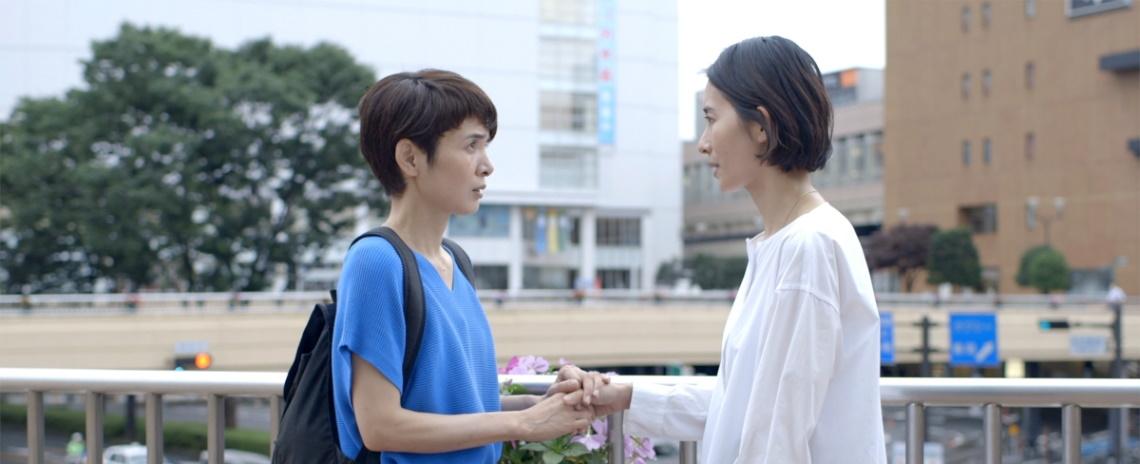There are stories of coincidence and chance, of intersections and strange things told, and which is which and who only knows? And we generally say, ‘Well, if that was in a movie, I wouldn't believe it.’ Someone's so-and-so met someone else's so-and-so and so on. And it is in the humble opinion of this narrator that strange things happen all the time.
This is not a quote from Japanese director Ryûsuke Hamaguchi regarding Wheel of Fortune and Fantasy, his latest that makes its North American premiere at the New York Film Festival this week, but it could be. That narrator quoted above is the one of Paul Thomas Anderson’s Magnolia, the director’s 1999 epic of human connection, chance, and destiny among a dozen or so L.A. inhabitants. Although its scope and style are anything but the operatic chaos machine of Anderson’s third feature, Wheel is – to over-explain the metaphor of its title – similarly concerned with circular connection and amorphous identities.
Winner of the 2021 Berlinale Silver Bear, Wheel of Fortune and Fantasy is only the third of Hamaguchi’s features to be distributed stateside. (His fourth will be the Haruki Murakami apdation Drive My Car, also slated for release soon.) Even though the logline for each of Hamaguchi’s films reads remarkably different from the next, their family resemblance is strong. They contain the unmistakable fingerprints of someone who may be one of cinema’s new masters.
As with Douglas Sirk and his Imitation of Life (1959), the title Wheel of Fortune and Fantasy is a perfect encapsulation of its maker’s cinematic modus operandi. Happy Hour (2015) was his first to be distributed stateside. Despite its five-hour runtime (or perhaps because of it), the Japanese epic about friendship (!) was something of a niche critical darling upon its U.S. release in 2017. It's a tale of free will versus determinism featuring four female thirty-somethings beset by romantic and moral problems. The story's inciting incident is a seminar during which the group attempt to find their physical and metaphysical centers. Within that early extended sequence, Happy Hour flirts with magical realism, but Hamaguchi’s following feature, Asako I & II (2017, released in the U.S. in 2019), is fully enamored with it. Vertigo by way of shojo, the lovelorn teenage yarn shared similar philosophical quandaries to its predecessor — this time with ghosts, doppelgängers, and/or ghostly doppelgängers. It befuddled some and beguiled others, and suggested Hamaguchi inching towards showering his next set of characters with Magnolia’s biblical rain of frogs.
Instead, the writer/director builds on the literary leanings of the Great Japanese Novel that is Happy Hour, presenting a triptych of three short stories, each about a woman who finds herself in a precarious and potentially life-altering position. Together, they make up the most modest work released here yet, at least by comparing it against the scope and ambition of his two previous outings. In “Magic (or Something Less Assuring)”, Meiko (Kotone Furukawa) discovers that her friend’s new unbelievably romantic flame might be her one from her own past. “Door Wide Open” is a battle of wills between Nao (Katsuki Mori) and the college professor (Kiyohiko Shibukawa) whom she’s attempting to ensnare in a sex scandal on behalf of her much younger lover. In “Once Again”, Moka (Fusako Urabe) has a chance encounter with a woman (Aoba Kawai) who may or may not be her high school girlfriend.
Although what happens in Wheel is from a movie, one would credibly believe it. These strange things do happen all the time. Hamaguchi has, by definition, contrived these uniquely complicated circumstances, but within each he’s also crafted fully flesh-and-bone people who react and behave as such. Time is what allows him to pull off the seemingly contradictory magic trick. He luxuriates in purposefully extended sequences that gracefully reveal his emerging talent as a supreme dramatist – one with an alarmingly precise insight into humanity’s irrationality. His worldview may be precision-cut, but the tools with which Hamaguchi presents it are as gentle as a butter knife. His three features to date available to U.S. audiences are gentle, giving, and probing melodramas: Tectonic plates move under Hamaguchi’s characters but he provides an uncommonly still support at the surface.
Critics love building equations in an attempt to describe how a film works – this writer has already pinned Wheel of Fortune and Fantasy as the anti-Magnolia Magnolia, in so many words. Sometimes it is difficult to characterize the sparks that occur in the space between the screen and the brain. Therefore, Ryûsuke Hamaguchi combines Rohmer’s moral fables; the mono no aware present in Naruse and Ozu (the latter’s trademark 180-degree line-breaking direct address is often borrowed); with the fascination of chaos, fantasy, and connection of Anderson, Altman, and Kieślowski. Still, there’s a pithier way of describing what’s unique about the experience of communing with his work, with his careful attention to the human experience and unique craft to display it: It’s just bliss.
Rating: B+
Wheel of Fortune and Fantasy was reviewed from a virtual screening at the 2021 New York Film Festival. The film will be released theatrically in select U.S. cities on Oct. 15.


